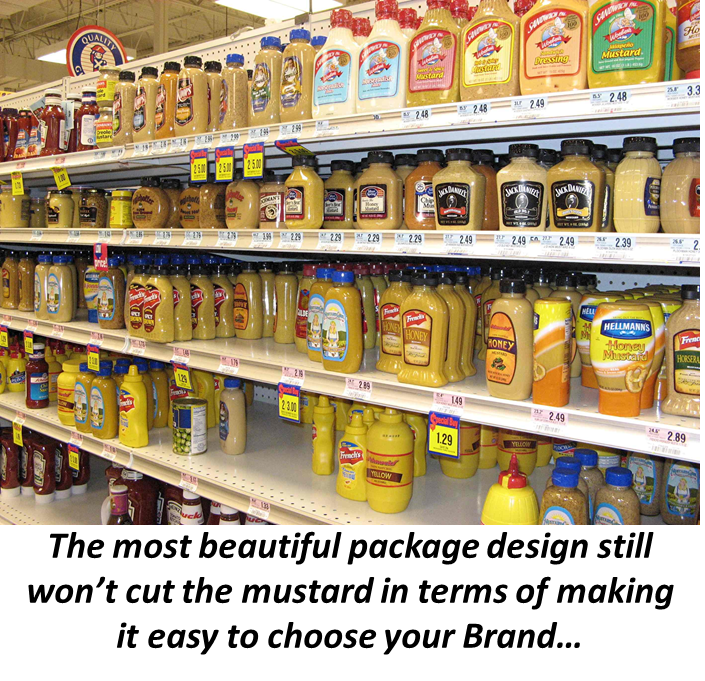The Small Business Brand Challenge: How To "Simplify Choice"
As a Small Business, you sometimes might go through some of these emotions:
1. "We're too small for anyone to notice"
2. "Our business is too boring to get any attention"
3. "We're not worthy of a big statement like that"
4. "The market is too crowded for us to stand out enough."
The reality is that you are not alone. I hear things like this from small businesses all the time. But the bigger players in your field are doing the same thing, and they have some of the same worries as you do. One recent client who's annual sales are just under $5MM is working in a $19 Billion industry, where most of the market has already been commoditized. In a situation like that, customers have DOZENS of choices, and will eventually find multiple vendors that will give them the price they want. So how do they narrow down the choices?

If you were going to select a new supplier who is selling what is essentially the same product as their competitors and at nearly the same price, would you choose one that stood for the current perceived Brand Values of our example from Part I, Bank of America, or one that talked the talk and walked the walk of a Rackspace? That's a pretty easy choice, isn't it?
You can spend all your money on brilliant design work, double down on advertising and put your logo on the Goodyear Blimp, but customers will see right through it if your Brand doesn't stand for anything of substance, nor carry any real authority in your category.
Why do people, when faced with two products of similar quality and performance, pay more for the one the one with Brand reputation?
Brands Simplify Choice. Period.
Understanding Your Brand: The Small Business Checklist
If you are an established business, don't go out there tomorrow and "decide" on your new Brand. First you need to know what your current Brand means to your employees and customers and THEN build on that. Here's a few things that will help you get there:
1. Understand Your Stakeholders - interviews with staff, customers and FORMER customers will be incredibly revealing if you are not doing this on a regular basis already. They'll know better than you will what you are good at, what you are NOT good at, what your competitors do better/worse than you, etc. These conversations often will point you to where you need to go as well. I often find that these conversation on their own will even deepen the relationships you have with these stakeholders - why? Because now they know you care.
2. Understand Your Context - Are you in a growing industry? A declining one? Or do you already have market share that makes growth more difficult? A goal of "doubling" your business in a declining industry is harder that in a growing one, but might be possible if you have specific advantages. Be very honest with yourself regarding where you have an advantage AND where you don't. Sometimes scaling back what you do can be a positive strategy for your Brand too.
3. Understand Your Real Value - Sometimes the product you think is the focus of your business is NOT why your customers came to you. In one case we worked with, the real driver behind many of their clients decisions was a result of one of their accesories, and the Brand positioning was promptly evolved to accentuate the value that product brought out for the audience out there. A re-examination of your value proposition is a critical element in the Brand strategy work.
4. Finally, Get an Outside Perspective - Be it an old business colleague you can rely on to be truthful or honest with you over a margarita, or a consultant that might cost you many margarita's, bite the bullet and bring in some outside eyes and ears on this. It's too important to your future to let your pride call the shots for you. And Brands that demonstrate being open and engaging with feedback tend to perform well from a customer's viewpoint too!
You Might Not Be National, But Your Competition Is
"Why do I need to do this?" you might still be wondering. "I'm a local Brand and want to be known locally and grow successful that way."
Certainly a valid goal. No, you don't need to go national yourself if your business has a target market locally that is big enough to keep you happy for years to come. But that doesn't mean you don't need to compete against others like you, or an even bigger threat: franchises.
you don't need to compete against others like you, or an even bigger threat: franchises.
The beauty of the franchise model is exactly what requires small businesses to think bigger. You might have a successful business that is as local as something like a maid/cleaning service. But you will still compete against Brands like Merry Maids which bring the power (and authority) of a national Brand to someone like you who is also a local business owner in their community.
Finally, note that a McKinsey survey in 2012 of 700 executives with "substantial influence on supplier selection" found:
"...that B-to-B purchasing decision makers consider the brand as a central rather than a marginal element of a supplier’s value proposition. Our survey found that decision makers say that brand is almost as important as the efforts of sales teams in encouraging them to make out a purchase order. In the US, for example, brands are seen as having an 18% share in the purchasing decision, compared to the 17 percent tied up in the sales effort."
You might be the best locally.
You might have the highest quality product.
You might be unmatched for excellent service.
But without focusing some of that effort on a solid Brand strategy...you will be leaving money on the table.
For those who would like to see some great execution-level examples of how your Brand makes a difference, set aside a bit of time to enjoy a great presentation from Marketing Experiments:





